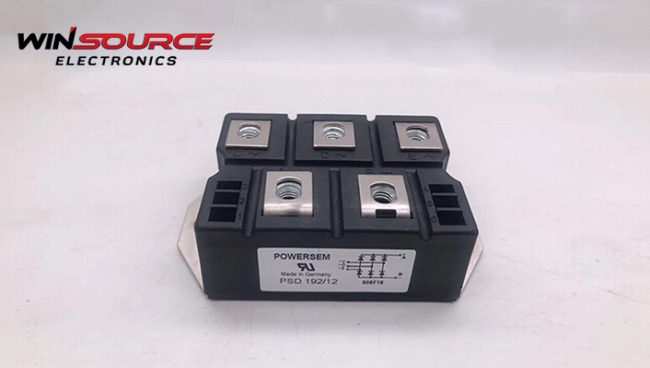
Semiconductor Power Modules
Developing and deploying semiconductor power modules represent a crucial advancement in electronic engineering. These modules, integral to various modern electronic devices, have revolutionized power management and efficiency.
Power modules are vital in facilitating high-power switching solutions, evident in applications ranging from electric vehicles to industrial machinery. Their compact size belies their significant impact, offering reliability and efficiency in a miniature package.
Advancing Power Efficiency and Design
Semiconductor power modules, exemplified by the Powersem PSD 192/12, are not just about managing power effectively; they represent a significant leap in design philosophy. Integrating components such as the DC-DC converter, controller, FETs, and inductor into a single package signifies a transformative approach to electronic design. Top of Form
1. Improved Efficiency and Performance in Power Modules
High-Frequency Soft Switching: A Leap in Efficiency
Power modules have experienced a significant boost in efficiency due to the adoption of high-frequency soft-switching technology. Gallium Nitride High Electron Mobility Transistors (GaN HEMTs) are instrumental in this advancement, offering lower driving loss and shorter dead circuit benefits.
Compared to traditional silicon MOSFETs, reduced gate charge (Qg) and output capacitance (Coss) results in efficiency gain. The GaN HEMTs, with their lower driving loss, offer considerable advantages in high-frequency soft-switching resonant topologies, such as LLC resonant converters.
Optimizing Power Density and Performance
In the field of power density, GaN HEMTs shine by enabling high-end adapter applications to operate above 600kHz, significantly increasing the power density to over 63W/inch3. The elevated power density is pivotal for low-power consumer applications like laptop adapters, flat-screen TVs, and all-in-one desktop computers.
Furthermore, GaN HEMTs’ ability to operate safely without incurring switching loss at high frequencies further solidifies their advantage in power modules.
They reduce the total loss, which includes driving, conduction, and switching off losses, thereby enhancing overall efficiency and reliability in power conversion processes.
2. Design Simplicity and Reliability in Power Modules
Streamlined Design Through Integration
The evolution of power module design has seen a shift towards greater functional integration and power density. Intelligent Power Modules (IPMs) exemplify this trend.
IPMs offer a more compact design by incorporating critical components like the gate driver circuit and power components into a single unit. The integrated approach streamlines the design process and significantly reduces the time to market.
For example, integrating power semiconductors, circuits, and resistors into the substrate utilizing thick-film technology enhances the functional integration of new flow IPM 1B power modules.
Enhancing Reliability with Advanced Technologies
Advanced manufacturing techniques and materials bolster the reliability of power modules. New assembly and packaging technologies and new materials are essential to meet the increasing demands for higher power and power densities, especially in challenging environments like hybrid cars.
Employing numerical modeling in the early design phases can improve power module reliability, thereby reducing the need for extensive prototyping and testing.
Such an approach helps correlate package design with reliability measures, addressing thermal expansion coefficient mismatches that can cause mechanical stresses and eventual failure.
Automated Quality Assurance for Consistency and Efficiency
Quality assurance (QA) plays a crucial role in manufacturing power modules. It involves processes that ensure consistent, high-quality levels in produced items. QA, a proactive component of quality management, encompasses defining processes, team training, tool selection, and auditing.
Effective QA prevents quality issues, leading to cost savings, and boosts efficiency and customer satisfaction. By reducing the incidence of defective products, resources can be better allocated to creating quality parts and pursuing other lucrative projects.
Advanced integration techniques, improved manufacturing processes, and rigorous quality assurance protocols underpin modern power modules’ design simplicity and reliability.
3. Maintenance and Flexibility in Power Module Use
Enhanced Maintenance and Flexibility
Power modules, known for their reduced board space and high first-pass success rates, are increasingly favored due to their simplicity in maintenance and flexibility.
Technological advancements are making power modules smaller and easier to use, which is essential in today’s environment, where engineers face constraints in both time and space.
The design and development cycle has become more compressed, and space availability for power delivery is limited. These factors drive significant growth in the power module market, leading to innovative solutions that enhance these components’ ease of use and flexibility.
4. Time and Cost Efficiency in Power Module Design
Streamlining Design with Advanced Technologies
Power modules significantly reduce design time and costs, which are crucial considerations in project management. For instance, designers face substantial challenges when designing power modules for various applications, including electric vehicle charging and IT equipment.
These include selecting the appropriate gate drivers and ensuring optimal power provision. Designing the power supplies that bias the gate drivers can consume significant engineering time and add complexity to the design and the bill of materials (BOM).
Advanced Technologies integrates a magnetic coupling device within the integrated circuit, transferring the gate logic signal and the power needed to drive the switch’s gate.
This technique eliminates the need for external auxiliary power supplies, thereby reducing the system size, simplifying the BOM, and reducing design complexity and cost.
5. Reduced Radiated Emissions in Power Modules
Low-Radiated Emissions: Ensuring System Interoperability
Power modules have evolved to significantly reduce radiated emissions, which is crucial for system interoperability and market compliance. A significant challenge in power module design is to combat both conducted and radiated emissions.
ROHM’s new Intelligent Power Module (IPM) inverters, specifically the 600V IGBT BM6437x series, illustrate this advancement. They boast best-in-class low-noise characteristics and reduced losses compared to previous generations, indicating a significant improvement in managing radiated emissions.
Electromagnetic Compliance
The importance of adhering to electromagnetic compliance standards in the design and marketing of power modules cannot be overstated.
Reducing aggregate noise sources, both conducted and radiated, is crucial to achieving compliance. ROHM’s IPM family, for example, demonstrates an improvement in radiated emissions of more than 6dB compared to similar products. Top of Form
Seeking an electronic component? WIN SOURCE is your ultimate solution! Explore our vast inventory. Experience hassle-free shopping and unmatched customer service today. Visit us now for all your electronic component requirements!

COMMENTS